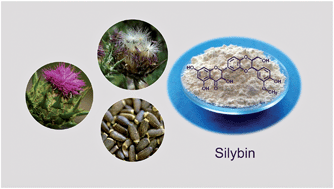Chemistry of silybin
Abstract
Covering: 1959 to 2013
Silybin, a secondary metabolite isolated from the seeds of the blessed milk thistle (Silybum marianum) was discovered as the first member of a new family of natural compounds called flavonolignans in 1959. Over the years it has received the research attention of many organic chemists. This research has resulted in a number of semisynthetic derivatives prepared in an effort to modulate and better target the biological activities of silybin or to improve its physical properties, such as its solubility. A fundamental breakthrough in silybin chemistry was the determination of the absolute configurations of silybin A and silybin B, and the development of methods for their separation. This review covers articles dealing with silybin chemistry and also summarizes all the derivatives prepared.


 Please wait while we load your content...
Please wait while we load your content...